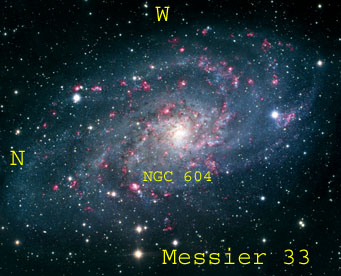A few weeks ago I wrote about a session observing the objects described in the November 2009 "Deep-Sky Wonders" column. I also observed a fair number of objects from earlier columns, so it was a pretty strenuous night all in all.

Robert Gendler
To reward myself at the end, I decided to take a quick look at Messier 33, the Triangulum Galaxy. I have very fond memories of observing this galaxy in 2004, when I was editing an article on M33 by Alan Whitman for the December, 2004 issue of S&T. Whitman identified more than 30 separate emission nebulae and star clouds within this galaxy using his 16-inch scope, and I was pleased to be able to see more than a dozen of those through my 12.5-inch Dob. So I figured I'd be able to see a few of them just at a glance.
On the contrary! At first glance, M33 was just a large, formless blob. It didn't take long to identify NGC 604, the brightest nebula, but after that I barely knew where to begin. Even the spiral pattern wasn't exactly obvious. And then I remembered just how long and hard I'd worked to find those dozen objects, with my labeled photo in hand.
M33 is paradoxical indeed. It's the 4th-brightest galaxy in the sky as measured by total brightness, but because of its relatively low surface brightness, it's extremely hard to see in light-polluted surroundings. Some beginners can't see it even through big telescopes under dark skies. It shows a wealth of detail, but picking out the individual components can be amazingly hard.
If you want to try identifying objects within M33 yourself, I've made Alan Whitman's article available as a 300-Kb PDF. Click here to read a summary of the article and to download the PDF, complete with a labeled photograph. That's what I'll be using next time I rendezvous with M33 and my 12.5-inch Dob.
 4
4









Comments
Mike Lynch
November 9, 2009 at 12:08 pm
By coincidence, I took my 20 x 80 binoculars to my dark-sky site in Central Kentucky on Friday night, and M33 was one of the objects I looked at. My expectations were fairly low, because I, too, recall a number of disappointing and frustrating attempts to see some detail in this galaxy.
I was pleasantly surprised that the galaxy was positively BRIGHT through the binoculars! I think the difference was the site, some distance from city lights, and a very clear, cool night. (The Milky Way was visible as soon as I got out of the car!)
I found the galaxy easily, and I could tell its shape with peripheral-vision looking.
The very next night, which was not as cool nor quite as clear, the view in a 5-inch rich-field scope was noticeably poorer.
Gotta get out a few more times--and take the 10-inch Dob with me--to see what else I can see. (I've spotted NGC 604 several times from other dark sites!)
You must be logged in to post a comment.
Doug Zubenel
November 10, 2009 at 3:01 pm
This post reminds me of observations (and the lack thereof) recorded in one of the now long-defunct amateur astronomy magazines from the early 1970's. The observer was perplexed by his ability to see M33 with a telescope, then on another night from the same site and with the same equipment and apparent sky conditions, not be able to see it at all. This puzzled me for many years, until I learned of the great variability of atmospheric airglow. While it is always present, sometimes it gets so bright that it can be clearly seen from an otherwise dark-sky site - especially if it is banded due to the upward propogation of gravity waves. Given an object with such inherently low surface brightness as M33, it can easily be overwhelmed by airglow, because the actual sky background can be brighter than it is.
You must be logged in to post a comment.
Doug Zubenel
November 10, 2009 at 3:01 pm
This post reminds me of observations (and the lack thereof) recorded in one of the now long-defunct amateur astronomy magazines from the early 1970's. The observer was perplexed by his ability to see M33 with a telescope, then on another night from the same site and with the same equipment and apparent sky conditions, not be able to see it at all. This puzzled me for many years, until I learned of the great variability of atmospheric airglow. While it is always present, sometimes it gets so bright that it can be clearly seen from an otherwise dark-sky site - especially if it is banded due to the upward propogation of gravity waves. Given an object with such inherently low surface brightness as M33, it can easily be overwhelmed by airglow, because the actual sky background can be brighter than it is.
You must be logged in to post a comment.
William Shackelford
November 13, 2009 at 8:50 pm
At the Okie/Tex Star Party on the morning of October 10, 2007 I observed M33 with 25 x 100 binoculars. The sky had become spectacularly clear and transparent after being cloudy earlier in the evening. I have always had trouble observing M33 but this morning the view was more than I could believe. Most if not all the galaxy was in the field of view and to my delight multiple arms were visible with direct vision and much detail with averted vision. Now that I know what to find I look forward to revisiting M33. Apparently a clear transparent sky is the key because I have not observed M33 as well since.
You must be logged in to post a comment.
You must be logged in to post a comment.